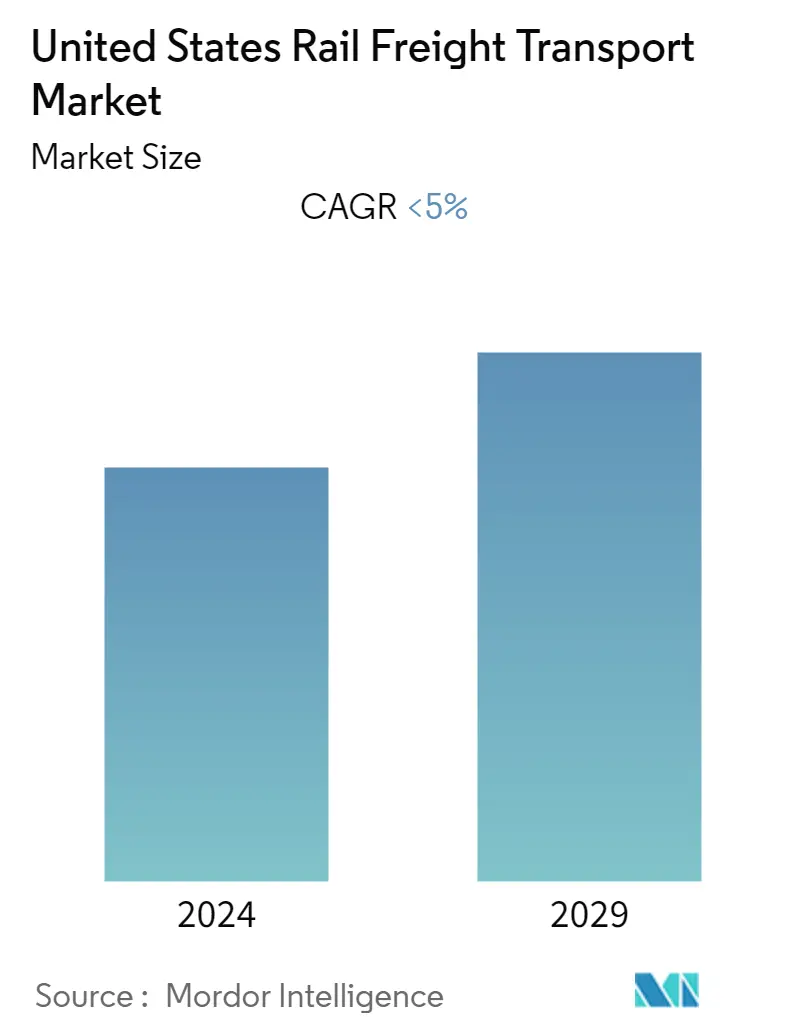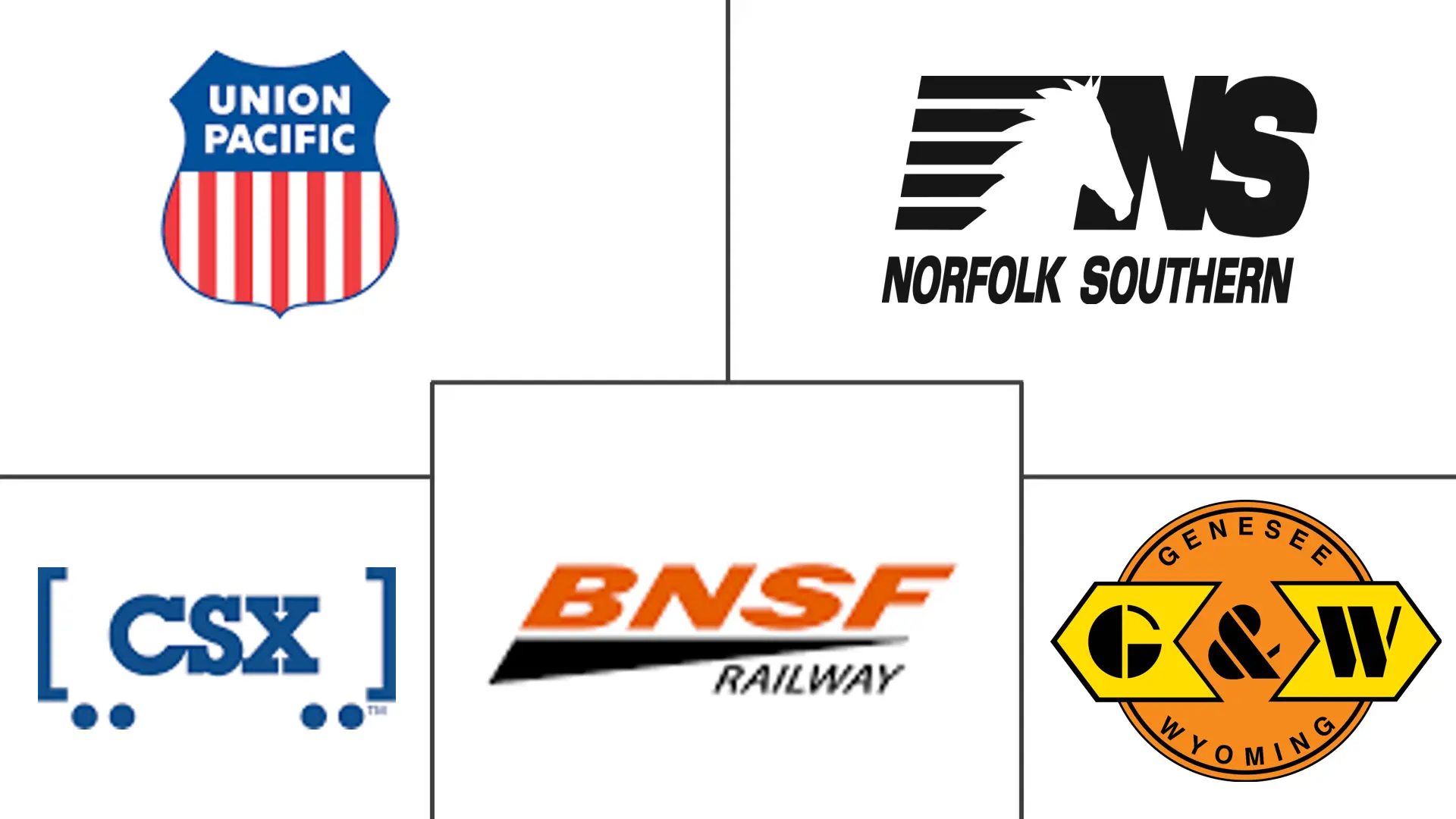Market Size of United States Rail Freight Transport Industry

| Study Period | 2020 - 2029 |
| Base Year For Estimation | 2023 |
| Forecast Data Period | 2024 - 2029 |
| Historical Data Period | 2020 - 2022 |
| CAGR | 5.00 % |
| Market Concentration | Medium |
Major Players
*Disclaimer: Major Players sorted in no particular order |
US Rail Freight Transport Market Analysis
The size of United States Rail Freight Transport Market is USD 69.1 billion in the current year and is anticipated to register a CAGR of over 9% during the forecast period.
- The Association of American Railroads estimates that the U.S. freight rail network runs approximately 140,000 miles of privately owned track in all states but Hawaii. It transports one-third of all exports from the United States and around 40% of all long-distance freight.
- As consumer spending and trade levels grow due to the COVID-19 (coronavirus) pandemic, freight volumes and demand for rail transportation are expected to rise. Therefore, consumer and industry demand for products will rise, driving up industrial output levels.
- The demand for such high-speed, fuel-efficient services will increase, which will benefit operators in the rail transportation sector. North America's most significant market was the United States, where Class I railways often ranked among the top providers of freight transportation services.
- Based on freight revenue, BNSF Railway, Union Pacific Corporation, CSX Corporation, and Norfolk Southern were consistently ranked among the top 20 worldwide freight firms in 2020. By mid-2021, Class I railways had surpassed railroads in the Asia-Pacific area as some of the biggest railroad firms in the world.
- North American freight railways begun to bounce back from the COVID-19 pandemic's harmful effects by 2021. Union Pacific's economic performance in 2021 was restored to pre-pandemic levels with freight revenue of about USD 20.2 billion. Other Class I railways also saw a comparable rise.
- In December 2021, Canadian Pacific finalized the acquisition of competitor Class I railroad Kansas City Southern to maintain its competitiveness in the area. The company was projected to expand operations throughout the three major nations in the area as a result of the merger, with the United States expected to account for about half of the company's revenue.
US Rail Freight Transport Industry Segmentation
Rail freight transport is the usage of railroads and trains to transport cargo on land. It can be used for transporting various kinds of goods or some of the way between the shipper and the intended destination.
The United States Rail Freight Transport Market is segmented by Type Of Cargo (Containerized (Includes Intermodal), Non-containerized, Liquid Bulk), By Destination(Domestic, International), and By Service Type(Transportation, Services Allied to Transportation (Maintenance of Railcars and Rail Tracks, Switching of Cargo, and Storage)). The report offers market size and forecasts for the US Rail Freight Transport market in value (USD billion) for all the above segments. The impact of the COVID-19 pandemic is also covered in the report.
| By Type of Cargo | |
| Containerized (Includes Intermodal) | |
| Non-containerized | |
| Liquid Bulk |
| By Destination | |
| Domestic | |
| International |
| By Service Type | |
| Transportation | |
| Services Allied to Transportation (Maintenance of Railcars and Rail Tracks, Switching of Cargo, and Storage) |
United States Rail Freight Transport Market Size Summary
The United States rail freight transport market is a pivotal component of the country's logistics and transportation infrastructure, characterized by its extensive network of privately owned tracks spanning approximately 140,000 miles. This network plays a crucial role in the national economy by facilitating the movement of a significant portion of the country's exports and long-distance freight. The market is poised for growth, driven by increasing consumer demand and industrial output, which are expected to rise in the wake of the COVID-19 pandemic. The demand for efficient and high-speed rail services is anticipated to grow, benefiting major operators such as BNSF Railway, Union Pacific Corporation, CSX Corporation, and Norfolk Southern, which are among the top freight transportation providers globally. The market's resilience was evident as it began to recover from the pandemic's impact, with Class I railways regaining their economic footing and expanding their operations through strategic acquisitions and investments.
The rail freight transport sector in the United States is moderately consolidated, with significant competition from road and air transport services. Despite this, rail remains a cost-effective and environmentally friendly option for transporting goods over long distances, offering substantial efficiency and pollution reduction benefits compared to other modes of transport. The market is supported by ongoing investments in infrastructure and technology, such as the introduction of battery-electric locomotives to reduce greenhouse gas emissions. Major players are actively expanding their networks and enhancing capacity to meet growing demand, with significant capital investments directed towards infrastructure projects and equipment upgrades. These developments underscore the strategic importance of rail freight transport in the United States, as it continues to adapt and evolve in response to changing market dynamics and consumer needs.
United States Rail Freight Transport Market Size - Table of Contents
-
1. MARKET INSIGHTS & DYNAMICS
-
1.1 Current Market Scenario
-
1.2 Market Dynamics
-
1.2.1 Market Drivers
-
1.2.2 Restraints
-
1.2.3 Opportunities
-
-
1.3 Industry Attractiveness - Porter's Five Forces Analysis
-
1.3.1 Threat of New Entrants
-
1.3.2 Bargaining Power of Buyers/Consumers
-
1.3.3 Bargaining Power of Suppliers
-
1.3.4 Threat of Substitute Products
-
1.3.5 Intensity of Competitive Rivalry
-
-
1.4 Technological Trends
-
1.5 Government Regulations and Initiatives
-
1.6 Insights into Transport Corridors in Key Location
-
1.7 Spotlight on the Effects of the Belt and Road Initiative (BRI)
-
1.8 Review and Commentary on the Freight Transportation Costs by Rail
-
1.9 Elaboration on Key Trade Agreements Related to Rail
-
1.10 Insights into Key End Users of the Rail Freight Sector
-
1.11 Impact of COVID-19 on the Market (Short-term and Long-term Impact on the Market and the Economy)
-
-
2. MARKET SEGMENTATION
-
2.1 By Type of Cargo
-
2.1.1 Containerized (Includes Intermodal)
-
2.1.2 Non-containerized
-
2.1.3 Liquid Bulk
-
-
2.2 By Destination
-
2.2.1 Domestic
-
2.2.2 International
-
-
2.3 By Service Type
-
2.3.1 Transportation
-
2.3.2 Services Allied to Transportation (Maintenance of Railcars and Rail Tracks, Switching of Cargo, and Storage)
-
-
United States Rail Freight Transport Market Size FAQs
What is the current United States Rail Freight Transport Market size?
The United States Rail Freight Transport Market is projected to register a CAGR of less than 5% during the forecast period (2024-2029)
Who are the key players in United States Rail Freight Transport Market?
Union American, BNSF Railway, CSX, Norfolk Southern Corp. and Genesee & Wyoming Inc. are the major companies operating in the United States Rail Freight Transport Market.

